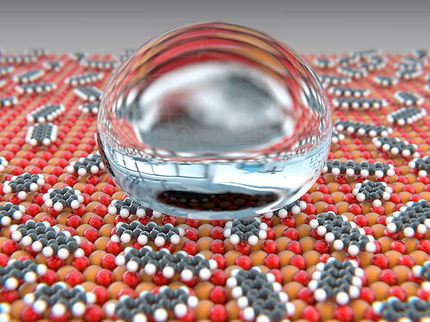Silicon chip "replaces" rare earths
rare earths are an expensive and necessary component of strong permanent magnets. However, their use for this purpose can be optimised and thereby reduced. This has been demonstrated in computer simulations by a Special Research Program funded by the Austrian Science Fund FWF. The results show that such magnets may contain local deformations in the crystal lattice of the material. These deformations are above all located at the boundary of material grains. According to the calculations of the St. Pölten University of Applied Sciences, the magnetic force of the material is weakened in these areas. This could be avoided by optimising the material structure, which would save resources by reducing the amount of rare earths required.
With an annual production of 150,000 tonnes, rare earths are really not that rare. The real problem is that they are rather difficult to extract. In view of rapidly growing global demand, a shortage is therefore imminent. Due to their particular chemical properties, rare earths are sought after for modern environmental technology. This is a good reason for the main exporter, China, to limit exports - and for other countries to optimise their use of the resource. High-end computer simulations, such as the computations from St. Pölten University of Applied Sciences, carried out as part of an FWF-funded Special Research Program, could make a major contribution to this optimization.
Crystal Crises
The team at St. Pölten University studied the exact structure of neodymium magnets. In addition to the rare earth element neodymium, the magnets consist of iron and boron. The head of the Industrial Simulations study course, Prof. Thomas Schrefl, commented on the recent findings: "Our simulations show disturbances in the crystalline structure in neodymium magnets. Such disturbances cause the magnetising direction to change in these areas. In a so-called anisotropic magnet, like the neodymium magnet, in which all parts must have the same magnetising direction, this phenomenon weakens the magnet." The team´s simulations show that such disturbances in the junctions between individual material grains occur when three different grains meet. In these triple junctions, a non-magnetic enclosure is formed and the crystal lattice near the enclosure is disturbed. In the same region, a high demagnetising field weakens the magnet further.
The influence of disturbances on the magnet´s behaviour were found in multiscale simulations that take into account several different dimensions: from the atomistic to the visible range. Conventional simulations were unable to cover this range of size until now. It was the combination of individual numerical computational methods, such as fast boundary element methods and tensor grid methods for computing the magnetic fields, which finally made it possible. The development was achieved by Prof. Schrefl´s team as part of the Special Research Program ViCoM - Vienna Computational Materials Laboratory.
Cohesion through movement
The spokesperson for the Special Research Program, Prof. Georg Kresse from the research group Computational Materials Physics at the University of Vienna, explained the aims of the Special Research Program: "We want to describe the correlated movement of electrons more accurately. This electron correlation is mainly responsible for the cohesion of solid-state bodies and molecules. An accurate description is therefore crucial for precisely predicting the mechanical, electronic and optical properties of materials."
In a total of twelve project groups, more than 50 scientists are working on describing material properties, which will be of key importance to numerous technologies of tomorrow, including microelectronics, solar technology and polymer production. What is more, the Special Research Program helps with the optimisation of magnetic and magneto-optical storage, as in high-performance permanent magnets for electric cars or wind turbines, thereby making a substantial contribution to developing future-oriented technologies. The work of this Special Research Program, which is funded by the FWF, therefore transcends mere scientific interest - as is clear from recent discussions about the availability and strategic importance of rare earths. It is a convincing testament to how insights acquired in basic research can rapidly gain unexpected import.
Organizations
Other news from the department science

Get the chemical industry in your inbox
By submitting this form you agree that LUMITOS AG will send you the newsletter(s) selected above by email. Your data will not be passed on to third parties. Your data will be stored and processed in accordance with our data protection regulations. LUMITOS may contact you by email for the purpose of advertising or market and opinion surveys. You can revoke your consent at any time without giving reasons to LUMITOS AG, Ernst-Augustin-Str. 2, 12489 Berlin, Germany or by e-mail at revoke@lumitos.com with effect for the future. In addition, each email contains a link to unsubscribe from the corresponding newsletter.



























































